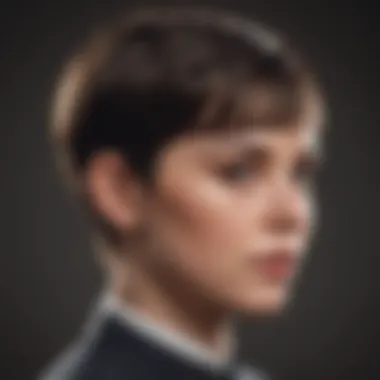The Cultural Impact of Short Hair in England


Intro
Short hair has been at the heart of English culture for centuries, representing various trends, beliefs, and social movements. The shift from long locks to cropped cuts reflects deeper societal changes—from issues of class and gender that evolved over decades to contemporary expressions of identity and personal freedom.
In this exploration, we will delve into both the historical and modern significance of short hair in England. Its evolution mirrors broader cultural dynamics and reveals much about the individuals who choose to express themselves through their hairstyles. Short hair serves as a canvas upon which identity, rebellion, and empowerment are painted.
By examining key moments in history, influential figures, and the ongoing dialogue about beauty standards, we hope to illuminate how this seemingly simple choice carries profound meanings in English society.
Prelude to Short Hair in English Society
Short hair holds a significant place in English culture, often intertwining with various sociocultural narratives. It provides more than just an aesthetic choice; it’s a statement that reflects personal identity, societal roles, and cultural shifts. In this exploration, we will dissect the layers of meaning associated with short hair, showcasing how it resonates across different eras and social strata.
The importance of analyzing short hair extends beyond mere fashion. For many, the decision to cut their hair short can symbolize a break from tradition or an embrace of liberation. As such, short hair serves as a cultural canvas where individuals can express their values, beliefs, and even their defiance against prevailing norms. Various contexts, from political movements to personal transformation, play a vital role in shaping the perception of short hair and its significance in English society.
Understanding Hair as a Cultural Symbol
Hair has long been regarded as a powerful symbol of cultural identity and personal expression. Across civilizations, it reflects deeper meanings tied to gender, status, and community belonging. In England, hair has borne witness to myriad transformations, and short hair, in particular, has emerged as a complicated narrative encapsulating both conformity and defiance.
Historically, hair status indicated social class and identity. For example, during the Tudor period, short hair on men was often a symbol of the bourgeois class, while long hair was commonly associated with nobility. That said, short hair can also express internal changes; when an individual opts for a change in hairstyle, they might be unwittingly signaling a shift in their life. In contemporary discourse, short hair on women has increasingly come to represent empowerment and equal footing in a traditionally male-dominated world.
From the bob in the 1920s to the pixie cut championed by style icons like Audrey Hepburn, short hair serves as a canvas for various sociopolitical statements. Its evolution has been shaped by many factors, such as the feminist movement, and so on, where it did not only signify a new era of womanhood but also marked a challenge to the limitations often imposed by long hair.
The Evolution of Hair Trends in England
The trajectory of hair trends in England reflects a broader social and cultural evolution. Throughout the ages, hairstyles have been influenced by a multitude of factors, including changes in governance, artistic movements, and the rise of individualism.
- Medieval to Renaissance: During the medieval period, hair was a symbol of virtue and societal standing. Women wore their hair long and often covered, while men’s shorter styles were sometimes dictated by their roles as laborers or knights.
- The Victorian Era: Fast forward to the Victorian era, where hair became emblematic of morality, particularly for women. Aspects of femininity were tied to long hair, while short hair on women was relatively rare, typically seen as an act of rebellion.
- The 20th Century: Rapid changes emerged in the 20th century. The aftermath of the World Wars saw short hair become more accepted among women, with the introduction of the iconic bob cut mirroring newfound freedoms in society. The 1960s brought further experimentation, with styles like the pixie cut gaining popularity.
- Contemporary Trends: Fast forward to today, short hair has become a widespread choice, representing not just fashion but a generational statement. Icons from various spheres continue to influence this trend, merging personal stories with a larger social narrative.
Short hairstyles in England, therefore, are an evolving dialogue reflecting the complex relationship between individual choices and broader societal values.
"Hair is everything. It’s a woman’s crowning glory; it defines her. And short hair embodies a certain courage to break away from conformity."
Ultimately, understanding the significance of short hair in English culture dovetails with recognizing its status as a rich narrative thread woven through historical and contemporary discourse. This exploration of short hair will reveal multifaceted meanings from empowerment and rebellion to its articulation of identity within a rapidly changing society.
Historical Overview of Short Hair
The journey of short hair in English culture is more than just a trend; it's a reflection of societal changes, norms, and values throughout history. Understanding the historical overview of short hair gives context to its significance today. Whether associated with rebellion, practicality, or fashion, the history of this hairstyle reveals a myriad of perspectives on personal expression and identity. This section endeavors to unfold the importance of historical contexts that have shaped short hair, diving into pivotal eras that forged contemporary understandings.
The Medieval Period and Hair Conventions
During the medieval period, hairstyles conveyed messages about social status, age, and gender. Men often wore their hair long and flowing, while women were expected to adhere to strict norms, covering their hair with veil or headdresses. The conventions of beauty and propriety weaved through the fabric of society. However, as we glance at historical records, we find short hair wasn’t absent. Noblewomen at times opted for shorter, styled looks, suggesting that even in a time of rigid norms, there was a subtle pushback against the expected. This acted like a thread in the expansive tapestry of English culture, hinting that preferences for hair were often tied to personal agency, even in restricted societies.
The Influence of the Industrial Revolution


Fast forward a few centuries, the Industrial Revolution ignited a whirlwind of change in English society, affecting everything from employment to personal style. With more women entering the workforce, practicality became paramount. Shorter hairstyles gained popularity not just among the women factory workers but also among the rising professional class. These hairstyles allowed for ease of maintenance, reflecting both the evolving role of women and a departure from the elaborate styles of previous eras. It symbolized a shift towards modernity, as the practicality of short hair blended seamlessly with the desire for style amidst bustling daily routines. Integrating convenience and beauty, short hair became a cultural phenomenon, fostering a sense of empowerment among working women.
Short Hair in the World Wars
The world wars marked another crucial epoch for short hair in England. During the First and Second World Wars, survival, practicality, and resource conservation were paramount. Women took on roles traditionally held by men, stepping into professions that necessitated short, manageable hairstyles. The iconic "Victorine bob" became synonymous with the spirit of the time, embodying resilience, strength, and defiance against adversity. Short hair became a symbol of allegiance and commitment, as women needed practicality in both their daily lives and burgeoning roles in society. Short hairstyles resonated with a newfound sense of freedom and identity, showcasing that hair could be as transformative as the times themselves.
In this historical overview, we see that short hair in England is not simply a matter of style. It encapsulates various elements of identity, societal shifts, and cultural conventions, laying the groundwork for the contemporary perspectives we will explore next.
The Cultural Significance of Short Hair
Short hair holds a unique place in English culture. Its significance stretches beyond mere fashion; it is intertwined with identity, freedom, and the narrative of societal norms. From its historical roots to its modern interpretations, short hair is a canvas for personal expression and a reflection of changing values. In a world where hair has often been deemed a symbol of one's social status or conformity, the choice to go short often requires a certain level of audacity, breaking conventional molds that dictate what is deemed acceptable or attractive.
Representation of Gender Identity
Short hair has, for many, become a powerful emblem of gender identity. Specifically, in English culture, it challenges archaic notions of femininity and masculinity. Traditionally, long hair was often associated with femininity, symbolizing grace and beauty. However, individuals like Jean Seberg and later, artists like Annie Lennox, showcased that femininity could thrive just as well, if not more so, in a short hairstyle. This shift allows individuals who identify as women to embrace a look that defies stereotypes, reflecting a more authentic sense of self.
Moreover, short hair can also act as a statement for those who identify outside the binary. Particularly within the LGBTQ+ community, short hair often represents freedom from societal expectations. It enables a rejection of traditional gender roles and fosters an environment where personal choice reigns over imposed standards. The simple act of cutting hair can serve as a metamorphosis of identity, granting individuals a visual representation of their inner truth.
Short Hair as a Statement of Rebellion
Throughout history, short hair has been closely linked to rebellion. It speaks volumes in societies where conformity is valued. In England, the flapper era of the 1920s is a prime example. Women chopped off their locks, portraying a stark divergence from the oppressed Victorian ideals of womanhood. Short hair during this period became synonymous with women’s liberation, leisure, and defiance against societal constraints. It was a bold declaration of independence—akin to hoisting a flag for change.
In more recent times, short hairstyles continued this trend of rebellion, particularly among youth subcultures. Punk rockers of the late 20th century donned mohawks and shaved sides, representing dissent against mainstream culture and a rejection of authority. Today, celebrities like Miley Cyrus and Kristen Stewart have made headlines for their short haircuts, challenging conventions and illustrating that rebellion can be both personal and political. In essence, short hair serves not just as a hairstyle—it's a manifestation of voices that refuse to be muted.
"Hair is not just an accessory; it's as much a part of one’s identity as the clothes they wear. To cut it short can be to cut away the past."
Short hair is more than just a fleeting trend; it encapsulates narratives of change, empowerment, and authenticity. The interplay between hair, culture, and personal identity makes it a significant focal point in understanding modern English society.
Contemporary Perspectives on Short Hair
Short hair in contemporary English culture encapsulates a vibrant tapestry of style, identity, and self-expression. As society evolves, so does the perception of short hair, which has transformed into a medium that speaks volumes about individual narratives and wide-ranging beliefs. Seeing it as more than just a fashion choice, understanding short hair's significance nowadays offers insights about personal empowerment and the shifting landscape of social norms.
Influence of Pop Culture and Celebrities
In recent years, pop culture has woven short hair into the very fabric of English identity. A wide variety of celebrities have sported short hairstyles, making them trendsetters in their own right. Figures such as Emma Watson and Miley Cyrus have not only changed their looks but have also sent ripples through societal expectations regarding femininity and beauty. These personalities stand as symbols of reinvention; many fans are inspired to take the plunge into short hair after seeing these bold changes.
Popular songs and movies also reflect this shift, often portraying short-haired characters as strong, independent individuals. For instance, the character of Furiosa, played by Charlize Theron in Mad Max: Fury Road, brought short hairstyles to forefront of action cinema. This influence has made short hair synonymous with empowerment, encouraging others to explore hairstyles that may have once been considered unconventional.
The Role of Social Media in Shaping Trends
Social media platforms have forged a new era for hairstyles. Instagram, TikTok, and Twitter bursting with hair transformation posts and tutorials have democratized hair styling. Users can easily search for hashtags like #ShortHairDontCare to connect with communities showcasing their experiences and showcasing their own styles. This change has significantly impacted how and why people choose to go short; they can see real-time results, diverse examples, and positive stories from others just like themselves.
Furthermore, the interaction between influencers and their followers creates a sense of belonging and solidarity. It’s not unusual to come across testimonials where individuals share how a new haircut led to a turning point in their life—whether it was liberating them from societal pressures or simply reclaiming their identity.


"Short hair reflects a movement, an expression of liberation. It's less about frills and more about personality."
Practical Considerations of Short Hair
Short hair not only carries cultural and societal implications but also presents its own set of practical considerations. These aspects can greatly influence why individuals choose to sport short hairstyles, providing various benefits alongside certain challenges. Understanding these practical elements helps in appreciating the complexity of short hair in English culture.
Maintenance and Care for Short Hair
Caring for short hair, while often perceived as simpler compared to longer styles, has its nuances. One of the primary concerns is regular maintenance to keep styles looking sharp and polished. Short hairstyles require frequent visits to the salon to ensure that the cuts remain fresh and flattering. This can be a boon for many, as it allows for more frequent updates, accommodating new trends or personal adjustments.
- Daily Care Routines: Unlike longer hair, short hair can be washed and dried much quicker. Many people find that they can reduce time spent on hair maintenance significantly. However, the type of products chosen becomes crucial. A lightweight leave-in conditioner or styling cream can help achieve the desired texture without weighing hair down.
- Styling Options: Despite its length, short hair can still be incredibly versatile. From sleek pixie cuts to edgy bobs, a range of styling options are at one’s fingertips. Implementing texturizing sprays or pomades can add volume or definition. This adaptability is particularly advantageous for those in various professional or social environments, allowing for a range of looks without the commitment of long hair.
In essence, while the maintenance of short hair is not without its requirements, the time efficiency and variety it offers appeal to many.
Short Hair and Professional Environments
In professional settings, hair can play an integral role in shaping personal image and perceptions. Short hair can be perceived as a mark of professionalism and confidence. A well-maintained short hairstyle often conveys an air of decisiveness, making it a popular choice among business professionals.
- Perceptions of Competence: Research suggests that individuals with shorter, neatly styled hair tend to be viewed as more competent and capable in work environments. This can be particularly significant in industries such as law, finance, or healthcare, where first impressions matter considerably.
- Gender Dynamics: The interpretation of short hair varies across gender, often influencing perceptions differently. For women, a short cut might challenge traditional notions of femininity, aligning instead with empowerment and independence. Conversely, men with solid, short hairstyles are frequently associated with traditional masculinity, enhancing their authoritative presence.
"Hair can be a powerful tool for creating identity, particularly in professional realms where appearances often speak louder than words."
When it comes to navigating workplace norms, adopting a short hairstyle can sometimes open doors while also keeping one firmly rooted in a professional atmosphere. Thus, short hair transcends mere aesthetics, evolving into a practical choice that holds substantial societal weight.
Short Hair Across Different Ethnicities
Short hair isn't just a fashion statement; it's a canvas reflecting a myriad of cultural narratives. Within the English context, various ethnic backgrounds contribute to how short hair is perceived and styled. This section examines the intricate relationship between hair and identity, showcasing the significance of short hair across different ethnic groups.
Diverse Hair Textures and Styles
Short hair styles vary widely depending on the ethnic backgrounds of individuals. Each texture—be it straight, wavy, curly, or coily—has distinct characteristics that influence how hair is cut and styled. For instance, a sleek bob might look sophisticated on straight hair but take on a completely different dimension of authenticity when styled in a curly texture.
One notable example includes the embracing of the fade haircut within Black communities across England. This style not only celebrates heritage but is often seen as a symbol of identity and pride. Moreover, various other cultures have their own versions. The Asian community, for example, often reflects sleek and polished trends like the asymmetrical bob which highlights the precision of straight hair. These styles serve not only as means of expression but also reflect broader cultural aesthetics and values.
Benefits of Diverse Interpretations
- Cultural Representation: Different styles showcase individuality and give a voice to various cultural identities.
- Inclusivity in Fashion: Fashion becomes more enriching, borrowing elements from various backgrounds and making it accessible to everyone.
- Empowerment: Short haircuts often symbolize boldness. When different ethnicities adopt them, it paves the way for conversations around self-acceptance and community pride.
Cultural Appropriation and Appreciation
While the exchange of hairstyles can be seen as an appreciation of diverse cultures, it’s crucial to navigate the fine line between cultural appropriation and appreciation. Cultural appropriation often occurs when elements of one culture are used by another, often without understanding their significance. Many styles that are regarded as trendy today may hold deep historical meanings for the cultures they originate from.
For example, the practice of wearing certain hairstyles by non-Black individuals can sometimes dilute the very issues of identity and struggle that many within the Black community face regarding their natural hair. This reality sparks conversations about who is allowed to wear what, and under what contexts it’s considered respectful.


"Understanding the context behind a hairstyle can prevent cultural insensitivity and foster deeper appreciation."
To appreciate rather than appropriate, one can consider:
- Education: Learning about the cultural significance behind a hairstyle can enrich one’s experience and understanding.
- Respect: Acknowledging the roots and history of styles can foster community respect and open discussions about diversity.
- Support: Supporting artists and creators from diverse backgrounds who originate these styles sustains cultural integrity.
Personal Stories and Testimonials
Personal narratives offer a rich tapestry of experiences that can illuminate the multifaceted impact short hair has on individuals within English culture. These stories serve as living proof of how hair, or the absence of it, can shape one's identity and signal broader cultural shifts. Through the lens of personal accounts, we can grasp the emotional weight and social dynamics intertwined with decision to embrace short styles.
Experiences of Transformation
Short hair has historically hung like an albatross around the necks of many women (and men too). The drastic move from long locks to a sleek bob or pixie cut often symbolizes a turning point in one's life. A particularly compelling story is from Sarah, a 34-year-old veterinarian from Bristol. After a rough patch in her career, she decided to chop her hair dramatically. "For me, it wasn’t just about hair; it was shedding layers of doubt and insecurity," she shares. This transformation wasn't merely aesthetic but reflected a deeper desire to embrace her true self.
It is fascinating how haircuts can coincide with radical life changes. Whether it’s a response to a breakup, a new job, or a personal epiphany, this choice can feel liberating. Many people report feeling empowered after a dramatic change. In fact, it often becomes a sort of rite of passage. The decision to cut off one's hair can evoke feelings of autonomy, allowing individuals to reclaim authority over their bodies.
Key Elements of Transformation Experiences:
- Symbolism of Change: Short hair often symbolizes personal growth or a new beginning.
- Empowerment: Many relate their hair transformation to a surge in confidence.
- Cultural Flavors: Each story reflects different societal norms and familial expectations around grooming and identity.
Short Hair and the Journey to Self-Confidence
For some, the journey to self-acceptance is intertwined with embracing shorter hairstyles. Jess, a 28-year-old artist from Manchester, reminisces about how society’s praises for her long curls shifted to disbelief when she opted for a buzzcut. "I thought people would judge me harshly, but the opposite happened. I felt empowered, and the compliments had an uplifting impact on my self-esteem," she states.
This sentiment resonates with many who have taken the plunge into short hair. The act of cutting their hair becomes more than just a physical alteration; it becomes a declaration of self-love and assurance.
"Your hair doesn’t define who you are, but it does represent how you feel about yourself in that moment," reflects a common perspective found in testimonials.
Reporting Self-Confidence Through Short Hair:
- Breaking Stereotypes: Short hair can challenge conventional beauty standards, enabling individuals to craft their own identities.
- Community Response: Stories highlight that group dynamics can either bolster or challenge confidence, leading to varied experiences.
- Expressing Individuality: A short haircut can easily become a canvas for self-expression.
Culmination: The Multifaceted Nature of Short Hair
Short hair holds a significant place in English culture, serving as a rich tapestry woven through history and modern identity. As we've explored in this article, the style transcends mere aesthetics; it embodies a wide array of social and cultural meanings. Short hair can speak volumes about one’s personal journey, showcasing a statement of rebellion, empowerment, or even cultural shift. This versatile style continues to adapt and transform, reflecting changing societal values and expectations.
Reflecting on the Ongoing Evolution
The evolution of short hair in English culture is anything but stagnant. A look back reveals varying influences, from the refined bob cuts of the 1920s to the punk-inspired choppy styles of the late 20th century. Each decade has embraced short hair with different cultural lenses, often in response to major socio-political shifts. Today, we see a resurgence, driven by notable public figures and a growing acceptance of diverse expressions in fashion.
"Short hair is not just a haircut; it’s a movement, a reflection of the freedom to express one's identity."
This ongoing evolution illustrates how external influences—such as advancements in fashion or shifts in gender norms—modify perceptions of short hair. With the rise of social media, trends spread like wildfire, encouraging new generations to explore and redefine what it means to wear short hair. Platforms like Instagram and TikTok have become valuable tools for showcasing transformative journeys and engaging with communities, while also challenging traditional beauty standards.
Short Hair as a Timeless Expression of Identity
Short hair stands as a canvas for individual identity, allowing personal stories to emerge in a bold, sometimes unconventional way. Many who've opted for shorter styles speak to the liberation it brings them. It can symbolize a break from societal pressures, a departure from conventional femininity, or simply an embrace of practicality. For some, it’s an act of defiance against outdated norms, while for others, it's a means of expressing an evolving sense of self.
In numerous accounts, individuals recount their transformative experiences associated with cutting their hair short. From feeling empowered to facing challenges head-on, the shift signifies more than just a change in length. It represents a journey towards owning one’s narrative, blending seamlessly into the broader cultural conversation.
Short hair, thus, remains a relevant and dynamic expression of identity within English culture. It evolves alongside societal norms, continuously reshaping itself to reflect the ever-changing landscape of personal and collective identity. Embracing short hair is not just about trend but about individual voices being heard in a society that thrives on diversity and self-expression.







